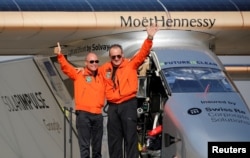Solar Impulse 2, an aircraft powered only by the sun's rays, took off from Cairo Sunday morning on what should be the last leg of its history-making flight around the world.
If all goes as planned, pilot Bertrand Piccard will steer the plane across the Arabian Peninsula and land in Abu Dhabi early Tuesday, completing the first global airplane flight using only energy from the sun — not a single drop of aviation fuel.
Piccard and the project's co-founder, Andre Borschberg, have taken turns flying Solar Impulse 2 since departing from the United Arab Emirates in March 2015 to begin their 35,000-kilometer journey around Earth. The plane can carry only one pilot.
Piccard says circling the world in the pioneering aircraft is both an adventure and a project that can lead to a better world: "If we want to protect the environment, if we want to fight climate change ... if we want to give access to energy to the poorest people in the world, to the most remote villages, we need renewable energy."
Solar Impulse 2, built of lightweight materials, is an enormous but slender aircraft. Its wingspan is wider than that of a Boeing 747 jumbo jet, but the entire plane weighs less than 2,300 kilograms, including 17,000 solar cells that convert sunlight into electrical energy.
The energy is stored in lithium batteries, which allows the plane to keep flying during the night. Its slow flying speed — only 10 percent to 15 percent as fast as a jetliner, or near top speed for an ordinary car — makes it necessary to stay aloft for days on end.
Stops on its global journey have included Oman, India, Myanmar, China, Japan, Hawaii, several U.S. cities and Spain. The plane arrived in Cairo about two weeks ago.










